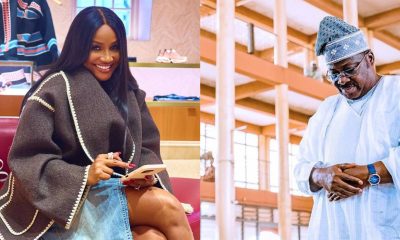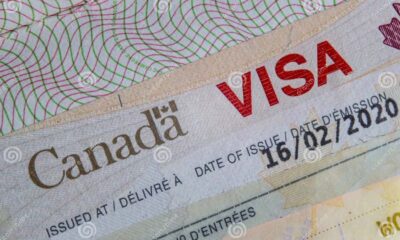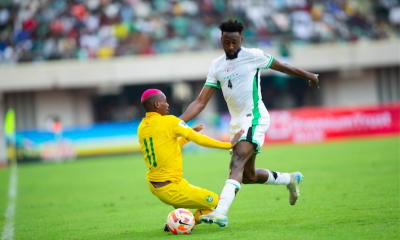International
Ukraine faces war bleak future as drones open new battlefront

Ukraine faces war bleak future as drones open new battlefront
The black box sits on the army truck dashboard like a talisman, its tiny screen lighting up with warnings when Russian drones are above us. We are driving fast along a country road in the darkness near the front lines outside Kharkiv.
Like many in this war, the soldiers inside have come to revere the little cube they call “sugar”; it warns of the unseen dangers above.
On the vehicle’s roof are three mushroom-shaped antennas that make up separate drone-jamming equipment. The car emits an invisible aura of protection that will thwart some, but not all, of the Russian attack drones patrolling the skies above this battlefield.
“It has detected the Zala Lancet Russian drones,” says Senior Lt Yevhenii, 53, from the front passenger seat, describing one of the most powerful long range Russian drones and its targeting drone. “Is that why we’re driving so fast?” I ask, aware that the drone-jamming antenna is useless against a Lancet.
“We’re not a priority for them, but it’s still better not to slow down because it’s very dangerous,” says Yevhenii, from the Khartia Brigade of Ukraine’s National Guard.
The jamming equipment blocks roughly 75% of frequencies that drones use to communicate with their operators, but some like the Lancet are difficult to block because they are entirely autonomous once their target has been marked. Because of the Lancet’s power, it tends to be used on larger targets, such as armoured vehicles or infantry positions, the Ukrainians say.
Almost none of this technology was here in Ukraine a year ago; now it is commonplace. Drones, which were once peripheral to the war are a central component for both sides, alongside infantry and artillery as Ukraine struggles to hold back Russian advances.
Ukraine has been thrown into the bleak future of war, where within minutes individual soldiers, fast-moving vehicles and trench positions can be precisely targeted. Drones have civilians in their sights too: about 25 from Russia attacked Kharkiv on Tuesday night, although most were intercepted.
READ ALSO:
- Methodist Church disowns group promoting LGBTQ in Gombe
- Hundreds killed in first 10 days of hostilities in south Lebanon
- US Congress cheers Netanyahu address, protesters gather to denounce it
Ukraine’s army is fighting back with its own drones, and there are dozens across this stretch of front line. One Ukrainian soldier tells me every day they kill 100 Russians.
The last images from drone cameras are usually of men panicking, their arms flailing, weapons firing before they are killed. The brigade’s 37-year-old drone commander, who goes by the call sign Aeneas, says that without shelter in a building there is little chance of survival – for Russians, and his men too.
“It’s the new way or a new path in modern war. In 2022 it was only infantry war and today one half is only a war of drone, a battle between Russian drones and ours,” he says.
The move to drone warfare is a combination of necessity and innovation. Drones are in plentiful supply, even though when armed they lack the explosive fire power of artillery.
Ukraine has consistently run short of artillery shells, and its allies have been slow to produce and supply them. But a Drone Coalition of Ukrainian allies has pledged to supply the country with a million drones this year.
Russia has made its own innovations on the battlefield too, using an older technology, and the village of Lyptsi, just six miles (10km) from the Russian border, has paid the price.
It was devastated by glide bombs – Soviet-era “dumb bombs” fitted with fins and a satellite guidance system. Some are as large as 3,000kg (6,600lbs) and, when launched from aircraft, glide onto Ukrainian infantry positions and towns to highly destructive effect.
One woman named Svitlana, who was driven out of Lyptsi by these attacks, told us: “Everything was exploding all around. Everything was burning. It was scary there. It was impossible to even get out of the cellar.”
Aeneas takes us on a tour of his drone teams, embedded along the front line in Lyptsi. Every vehicle we encountered near there was fitted with drone-jamming equipment; but the jammer’s protection ends when you exit the vehicle.
It’s dangerous to be caught out in the open, so we follow Aeneas running across the rubble for cover. All the while the BBC’s own drone detector calls out calmly into an earpiece: “Detection: multiple drones, multiple pilots. High signal strength.”
Out of breath, we make it to the drone unit’s underground base beneath a ruined building, where we are introduced to two operators, Yakut and Petro. There are drones on every surface, next to a frying pan with their evening meal. They get through many hundreds of drones in a month, as most are single-use and detonate on their target.
Their weapon of choice is the First Person View (FPV) drone, which carries a payload of between 1kg (2.2lbs) and 2kg of explosive, packed with shrapnel. The drones are modified off-the-shelf models which have cameras to send video back to their remote operators. “We call them celebration drones in Ukraine. They were used to film weddings and parties before the war,” Aeneas says.
READ ALSO:
- HIV prevention: Experts excited about trial results of injectable Lenacapavir
- Hardship: Nigerian students gear up for nationwide protest
- Edo couple who trafficked woman to Dubai jailed 5 years
I watch on a screen in real time beside Yakut who is fixed in concentration flying a drone manually to a target, across open fields and woodland. “He knows every puddle, every tree in the area,” Petro says.
The FPV drone approaches a building where a Russian soldier is believed to be hiding. It flies through an open window and detonates, the operator’s screen turning to static as the signal is lost. At the same time, another drone team is targeting a Russian Tigr light-armoured vehicle and scores a direct hit, captured by a second surveillance drone that’s watching from above.
The men stay on these positions, flying missions day and night, for up to five days at a stretch and spend as little time outside as possible. Their biggest fear is glide bombs: one landed nearby earlier that week, and the whole building shook. What happens if there’s a direct hit? I ask Petro. “We die,” he replies.
Aeneas shows me a recording from earlier in the week: a Russian soldier is caught in the open and the unit’s drone has him in its sights. The soldier notices it and runs for cover, hiding in a drainage culvert by the roadside. Slowly the drone lowers to its level, checking one side of the drainage pipe, then going around the other side, where the soldier is hiding. It detonates and the man is blown out, dying by the roadside. “He was divided into two parts,” explains Aeneas.
The operators are cool and dispassionate, almost clinical in their targeting and killing. They are as far as three miles (5km) away from their targets, one step removed from the immediate blood and guts of the battlefield. But encountering these weapons on the frontline is nerve-wracking.
A few days later, after dark, at an infantry trench close to Russian positions, a unit commander tells me he believes the Ukrainians have the upper hand in drone warfare, the Russians the advantage with glide bombs.
Russia also has the advantage in drone numbers: six for every Ukrainian one, although the drone teams I was with say they have the technological edge and are quicker at finding ways to counter-attack and jam Russian drones.
The trench is in a wooded copse, surrounded by fields, a thick canopy of trees provides cover.
But as we are speaking a Russian FPV drone is detected and begins to move closer to the position. The few dim lights, mostly phone screens, are turned off in the trench, and the men sit silently as the drone’s approach gets louder. We hold our breath as it hovers overhead. For what seems like an age, no one dares move. But then the drone moves on, in search of another target.
The largest drone in the brigade’s arsenal is the Vampire, which with its six rotors is the size of a coffee table. Again we join Aeneas on another mission in Lyptsi after dark, under the sound of constant artillery fire, where we meet the heavy bomber team. They work to attach the bomb to the drone.
“Ten kilograms, the Russians call this drone the Bogeyman,” says Aeneas. It’s payload is powerful enough to take out their intended target, a Russian command post, they say.
As the men work, a Russian drone makes a number of passes overhead: each time it does, the soldiers retreat into the basement, wait for the all-clear, then resume the assembly. As the drone takes off into the night in a cloud of dust, they watch its progress again from a second surveillance drone.
Just then, with barely any warning, we see on the drone’s thermal camera three Russian glide bombs detonating over the Ukrainian position, over a kilometre away. The shock waves are visible: seconds later they reach our location and the house around us shudders violently.
Ukraine’s allies know that by supporting the drone effort, they are helping the country’s cause, but it isn’t simply an act of charity.
The head of the British military, Admiral Sir Tony Radakin, has said that the UK’s armed forces can learn from Ukraine how to fight future wars. He said in a speech on Tuesday that he wants the Army to have “battalions of one-way attack drones”.
Aeneas and his men know this. As we leave their position, a Russian drone returns and we drive off at speed into the darkness. In the truck he tells me: “No one is fighting war this way – they are learning from us. This will be the future war.”
Ukraine faces war bleak future as drones open new battlefront
BBC
International
$100m coin collection buried for decades to be auctioned

$100m coin collection buried for decades to be auctioned
A coin collection, much of which remained buried underground for over 50 years, is expected to surpass $100 million at auction, according to experts.
Named the Traveller Collection, this extraordinary assemblage is believed to be the most valuable coin collection ever brought to auction.
The coins will be sold gradually over the next three years, with the first auction set for May 20.
Beyond its immense value, the collection’s origins make for a fascinating tale.
Spanning over 100 territories and encompassing coins from ancient times to the modern era, the collection is being auctioned by Numismatica Ars Classica.
What sets it apart is that most of the coins remained hidden underground for half a century before resurfacing.
According to a press release shared with CNN, the anonymous collector behind the collection began acquiring gold coins after the Wall Street Crash of 1929.
Over time, he developed “a taste for coins with great historical interest, beauty and rarity” and eventually amassed approximately 15,000 coins.
During the 1930s, he and his wife traveled extensively across the Americas and Europe, acquiring rare and historically significant coins while meticulously documenting their purchases.
READ ALSO:
- EFCC re-arraigns son of ex-PDP chairman for alleged N2.2bn oil subsidy fraud
- Group says Natasha’s recall will deepen democracy
- We welcome Gov Makinde’s U-turn on Shari’ah panel – MURIC
Despite settling in Europe at a time when Hitler’s Nazi party loomed over the continent, the collector sensed the impending danger. In response, he carefully packed the coins into cigar boxes, which were then placed inside aluminum containers and buried underground, where they remained undisturbed for five decades.
Among the collection is a 50 Toman coin, part of an “exceedingly rare” set minted in Tehran and Isfahan during the late 18th and early 19th centuries.
International
AI will replace doctors, teachers, others in 10 years – Bill Gates

AI will replace doctors, teachers, others in 10 years – Bill Gates
Bill Gates, a co-founder of Microsoft, has claimed that improvements in artificial intelligence (AI) over the next decade may render humans superfluous for the majority of work.
In a recent interview with comedian Jimmy Fallon on NBC’s The Tonight Show in February, the billionaire philanthropist discussed how AI may take over many facets of life and business.
Gates remarked that expertise is currently “rare”, emphasising the continuous reliance on human specialists in industries such as medicine and education.
For example, we continue to rely on highly trained individuals, such as “a great doctor” or “a great teacher”, whose knowledge cannot be simply replaced by AI.
However, “with AI, over the next decade, that will become free, commonplace — great medical advice, great tutoring,” Gates said.
READ ALSO:
- Senate seeks FG’s immediate intervention to slash data prices
- Reno Omokri: Nigeria gives more opportunities than US, Britain, Canada
- Driver remanded for causing Osun varsity students’ death
In other words, Gates believes that the world is entering a new era of “free intelligence”, as he described in a recent interview with Harvard University professor and happiness specialist Arthur Brooks.
According to Gates, this transition will result in rapid breakthroughs in AI-powered technology, making them more accessible and affecting almost every part of our lives.
These breakthroughs will vary from more effective treatments and diagnoses to widely available AI instructors and virtual assistants.
“It’s very profound and even a little bit scary — because it’s happening very quickly, and there is no upper bound,” Gates told Brooks.
The discussion of how humans will fit into an AI-powered future continues.
Some analysts suggest that artificial intelligence will improve human productivity rather than completely replacing labour, hence driving economic growth and creating new jobs.
However, Microsoft AI CEO Mustafa Suleyman cautions that technological improvements in the coming years will disrupt the nature of most occupations across nearly all industries, potentially exerting a “hugely destabilising” influence on the workforce.
AI will replace doctors, teachers, others in 10 years – Bill Gates
International
Poland suspends migrants’ right to apply for asylum

Poland suspends migrants’ right to apply for asylum
Poland has temporarily suspended the right of migrants arriving in Poland via its border with Belarus to apply for asylum.
Prime Minister Donald Tusk announced it would be happening after the controversial bill, which will allow Polish authorities to suspend this right for up to 60 days at a time, was signed into law by President Andrzej Duda.
Tusk had said it would be adopted “without a moment’s delay” while Duda said the changes were needed to strengthen security on the country’s borders.
But the law has been criticized by rights groups including Human Rights Watch, which said the EU should take legal action against Poland if it was implemented.
The group urged the country’s parliament last month to reject the bill, saying it “flies in the face of Poland’s international and EU obligations” and could “effectively completely seal off the Poland-Belarus border, where Polish authorities already engage in unlawful and abusive pushbacks”.
READ ALSO:
- Trump slaps 25% tariffs on car imports to US
- Reps pass bill to strip Vice President, governors, deputies of immunity
- Businessman collapses in court during trial over $578,000 cash seizure
The government said previously the suspension would only be applied temporarily to people who pose a threat to state security, for example large groups of aggressive migrants trying to storm the border.
Exemptions will be made for unaccompanied minors, pregnant women, the elderly or unwell, anyone exposed to “real risk of serious harm” by being returned and citizens of countries accused of conducting the instrumentalization of migration – like Belarus
Tusk has dismissed criticism from human rights groups.
“Nobody is talking about violating human rights, the right to asylum, we are talking about not granting applications to people who illegally cross the border in groups organised by Lukashenko,” he said in October.
Since 2021, Poland, Lithuania, Latvia and Finland have seen a huge increase in the number of people crossing into their countries illegally from Belarus and Russia.
Polish authorities have sent thousands of troops and border guards to police its border with Belarus and built a 5.5-metre-high steel fence along 186 km of the frontier where at times several thousand migrants have been left stranded.
Rights groups estimate more than one hundred people have died on the borders between Belarus and Poland, Lithuania and Latvia since 2021.
EU eastern flank countries and the European Commission have accused the Belarusian and Russian authorities of weaponising migration to create a new route into the EU to destabilize the bloc.
Poland suspends migrants’ right to apply for asylum
BBC
-

 metro1 day ago
metro1 day agoRivers administrator Ibas fires Fubara’s political appointees
-

 metro1 day ago
metro1 day agoJUST-IN: Ex-Oyo gov Ajimobi’s first child Bisola dies At 42
-

 International2 days ago
International2 days agoCanada removes bonus ranking points for job offers in Express Entry system
-

 metro2 days ago
metro2 days agoHow ritualists, native doctor drugged, murdered underage sisters in PH – Police
-

 metro1 day ago
metro1 day agoFG declares public holidays for Eid-el-Fitr
-

 Sports3 days ago
Sports3 days agoNigeria’s Super Eagles falter in W’Cup qualifiers against Zimbabwe, S’Africa lead, Egypt, Morocco qualify
-

 metro2 days ago
metro2 days agoAkpabio has habit of abusing women, says Atiku
-

 Africa1 day ago
Africa1 day agoNiger coup leader sworn in as president for five years













